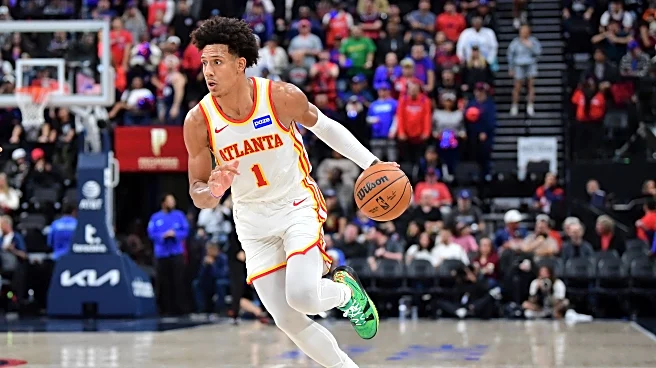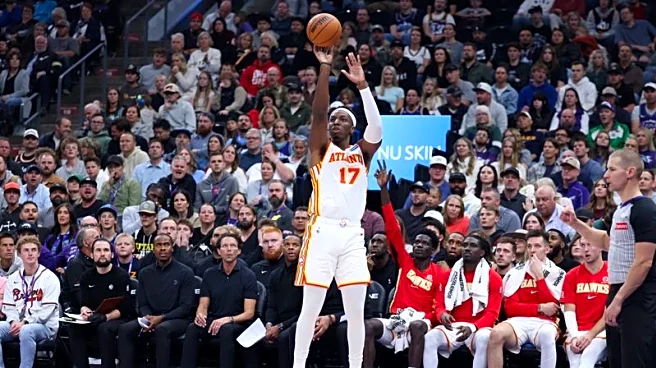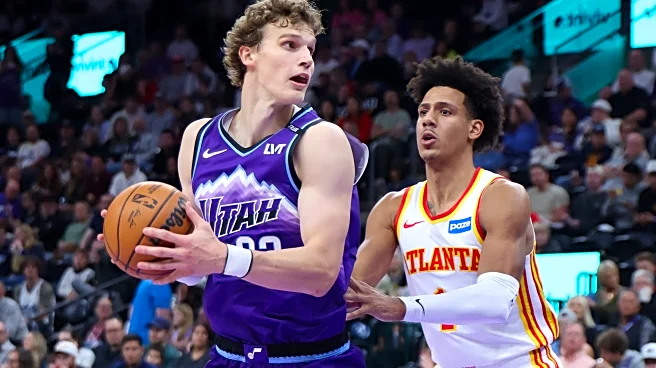Are the Atlanta Hawks really better off without Trae Young?
I am skeptical, but the honest answer is that it’s too soon to tell. As is the case for all 30 NBA teams, it would be foolish to draw any sweeping
conclusions about the Atlanta Hawks just 13 games into the 2025-26 season.
The team you saw defeat the Utah Jazz on Thursday night is a far different version from the one you’ll see in January. The team you’ll see in January won’t be the same as the one you’ll see in April, and perhaps even May.
There’s no question that the Hawks started off the season slowly. They got embarrassed on their home floor in a 20-point loss to the Toronto Raptors on opening night, and went just 1-3 through their first four games*. On offense, the shooting numbers weren’t pretty, and they very much looked like a team still searching for its identity after overhauling their rotation this summer. On the defensive end, an inability to protect the rim, second-chance points and non-existent transition defense were killing them.
*One of which came against the juggernaut that is the Oklahoma City Thunder – who are 12-1 and lead the league with a net rating of +15.6 points per 100 possessions.
Then, in a ‘get right’ game against a shamelessly tanking Brooklyn Nets team, they lost Trae Young to a MCL sprain just 10 minutes into the contest. Talented as Young is, his injury gave the Hawks a clear direction on both ends of the floor. His defensive shortcomings have been well documented, but Young was the straw that stirred the drink for Atlanta’s halfcourt offense.
In his absence, the way to win would be to defend as if their lives depended on it, and run like hell on offense – as their best chance to score without Young is to generate early shot-clock advantages in transition.
After escaping with a five-point win against Brooklyn, Atlanta alternated wins and losses over their next four games. While the defense indeed looked better without Young, the offense was hit-or-miss. They looked good in wins over Indiana and Orlando but committed 23 turnovers in their loss against Cleveland and shot just 34.4% from the floor in a defeat to the Raptors.
Then last week happened – and boy has the hype train already left the station or what? Atlanta went a perfect 4-0, thrashing the Lakers at home last Sunday before hitting the road for wins over the Clippers, Kings and Jazz.
Each game saw new heroes emerge. With Kristaps Porzingis, Jalen Johnson and Nickeil Alexander-Walker missing for the Lakers game, Mo Gueye took center stage, going off for 21 points, 7 rebounds and 7 assists. Dyson Daniels finished with a career-high 13 assists. Against the Clippers, Vit Krejci went nuclear from beyond the arc, shooting 8-for-10 from three-point range as Atlanta eked out a 105-102 win.
Against Sacramento, ball movement and defense were the co-MVP’s, as the Hawks recorded 42 assists on 49 made baskets and posted a stellar 92.6 defensive rating in a 33-point win. Against Utah, Jalen Johnson and Onyeka Okongwu each had career nights for Atlanta in a hard-fought victory, with Johnson going for 31 points*, 18 rebounds*, 14 assists* and seven steals*, and Okongwu hitting eight (!) threes en route to a career-high 32 points.
*All career-highs
It was truly a spectacular week of basketball, as Hawks fans got to witness the countless hours of effort that these players put into their craft pay off in real time. The vibes could not be better heading into tonight’s game against Phoenix.
Yet, the elephant in the room is that the Hawks are winning without Trae Young, playing a defense-first brand of basketball that does not appear to play to the four-time All-Star’s strengths. So… are they better off without him?
As I said, it’s too early to tell. Atlanta posted a 120.3 offensive rating last week, but none of the four teams they played rank in the top half of the league in defense. They also shot a blistering 43.8% from three-point range (40 attempts per game) after shooting just 33.2% (32.1 attempts per game) through their first nine games. How much of the offense is real? While the defense has looked much improved without Young, none of the four teams they played last week ranked in the top half of the league in offensive rating either.
What happens when they face a true test?
Atlanta have done very well on the multiple choice portion of this stretch without Young, but the free response section is coming up. Their next three games come against stiffer competition.
Up first (in a couple of hours) is the Suns, who have won five games in a row, and rank 11th in offense and 10th in defense. On Tuesday, the 11-2 Detroit Pistons (16th in offense, 3rd in defense) come to town. After that, the Hawks head down to Texas to take on Victor Wembanyama and the San Antonio Spurs (12th in offense, sixth in defense).
If Atlanta can come out of this stretch 3-0, a conversation will need to be had. If not, we can analyze where they fell short, and whether the addition of Trae Young would help in that area. Until then, just sit back, relax, and enjoy the Vit Krejci* show. We will find out a lot about this team over the next three games.
*shooting 17-for-23 (76.2%) from three over his last three outings. As always, shoutout Vit!
Now, onto some more observations on Atlanta’s early season play. Let’s talk about Mo Gueye and Dyson Daniels.
Mo Gueye’s Rim Protection
Atlanta’s defense has been elite* over the past eight games, and a big part of this improvement has come at the rim. After allowing their opponents to shoot 70% within 4-feet over the first five games of the season, Hawks opponents have shot just 61.4% from this range over the last eight games – the second lowest mark in the league over this span.
*2nd in the league in defensive rating since 10/31 – only OKC have been better
One player making a massive impact in this area is third-year forward, Mouhamed Gueye. Though he only plays around 17 minutes a night, Hawks opponents are shooting just 58.5% at the rim* when he is on the floor – a mark which ranks in the 95th percentile relative to lineups who have logged at least 100 possessions this season (per cleaningtheglass).
*For reference, San Antonio Spurs opponents are shooting just 55.8% at the rim with Victor Wembanyama in the game. Timberwolves opponents are shooting 57% at the rim with Rudy Gobert in the game.
Gueye is typically deployed at the ‘4’ alongside Onyeka Okongwu, and the two make for a really nice defensive tandem as both have the ability to defend out on the perimeter as well as protect the rim.
Against the Lakers, Okongwu swallows up Jake Laravia’s drive (who?), while Gueye mans the exit route. The ball gets kicked out to Smart, who works it back inside to Jaxson Hayes – but Okongwu and Gueye are waiting. Okongwu strips him, and the Hawks are headed the other way.
Later on in the third, Okongwu shows on the pick-and-roll, leaving Hayes open on the roll. This time it’s Gueye’s turn to make a play, meeting Hayes at the rim for a denial.
Another area where Gueye makes his presence felt is in transition.
Here, Anthony Black pushes the pace, sees Risacher in front of him and decides to take it to the basket – but he didn’t account for Gueye, who hunts him down for a chase-down swat*.
*Perhaps a goal-tend, but we take these.
Against Toronto, Gueye does a good job getting back in transition to impact Mamu’s shot-attempt.
While Gueye’s ability to cover ground on the defensive end is unique, his straight up defense is also pretty good.
From the Toronto game, the Hawks are in rotation on this defensive possession, but Krejci does a good job recovering to the corner. Mamu finds Barnes, who makes himself available with a nice flash cut, but he gets nowhere trying to draw a foul on Gueye.
Against Orlando, Gueye welcomes a switch onto Paolo Banchero then stifles him on the drive.
It’s been great seeing Gueye build upon his stellar play from last season. He’s been one of Atlanta’s most impactful defenders these first few weeks, and as we saw in the Lakers game, he may be starting to figure things out on the offensive end as well. If his three-point shot continues to develop, it’s going to be really hard to keep him off the court.
Minutes haven’t always been readily available for Gueye this season with Kristaps Porzingis, Jalen Johnson and Onyeka Okongwu all ahead of him in the front-court pecking order. Quin Snyder has also experimented with using Okongwu at the ‘4’ this season (which I have enjoyed), further eating into his opportunities.
For now, Gueye just has to keep making the most of the minutes that are available, but going forward I’d like to see Snyder try him out alongside Jalen Johnson or Kristaps Porzingis in the frontcourt*. So far, roughly 75% of his possessions have been played alongside Okongwu, but perhaps there are more lineup configurations involving Gueye that we haven’t seen before which could work as well.
*I might have to fire up 2K and see what happens if you play all three at the same time. Is anybody scoring on a Daniels, NAW, Johnson, Gueye, Porzingis lineup?
Dyson Daniels’ Drives
One more nugget I wanted to share involves Dyson Daniels. It’s been a rough start to the season shooting-wise for ‘The Great Barrier Thief’. He is just 27-for-47 (57.5%) at the rim through the first 13 games (well below last year’s conversion rate of 65.4%) and looks to be completely uninterested in shooting threes, averaging fewer than one attempt per game thus far.
That being said, in the wake of Trae Young’s injury, Daniels has had to take on a more prominent role in the offense, and I’ve been really impressed with how he’s responded – particularly given his shooting struggles early on.
Since Young went down, Daniels ranks 15th in the NBA in drives at 13.9 per game. This number ranks no. 1 on the team over this span and is a significant uptick from the first four games of the season (when Young was healthy) when he was averaging just nine per game.
These drives are less about scoring, and more about collapsing the defense in order to create an opportunity for others. Daniels assist percentage off drives over this recent stretch (17.1%) ranks fifth amongst the 49 players who average at least 10 drives per game.
Against Indiana, he takes Nesmith off the dribble, engages Jay Huff, then finds Gueye for a slam.
Against Cleveland, he gets in the lane then finds the cutting Okongwu for an easy two.
Against the Kings, he muscles his way into the lane, draws two, then finds Kennard in the corner for three.
Against Utah, he puts pressure on the defense in transition, then kicks it out to Okongwu at the top of the key for a triple.
Daniels is averaging 6.9 assists per game (two turnovers) since Young went down after averaging just 2.3 assists per game (two turnovers) while sharing the backcourt with Young. Hopefully the shot starts falling soon, but even if it doesn’t, Daniels has proven he can be an effective offensive player without it.
Obviously it’s still early, but one of my favorite whacky numbers thus far is that Daniels leads the team in offensive on/off impact this season – with Atlanta posting a 121 offensive rating with him on the floor relative to a 104.9 offensive rating with him on the bench. Yes, you read that right. Now I’d be surprised if this disparity holds as the season goes on, but even so, it’s a testament to the fact that Daniels is doing something right on the offensive end.
Keep on hoopin’ Dyson!
All stats used in this article are from nba.com/stats, cleaningtheglass, or pbpstats.













